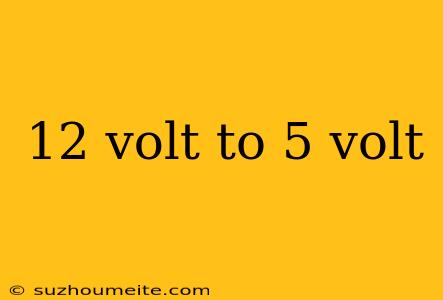12 Volt to 5 Volt: Understanding Voltage Conversion
When working with electronic circuits, it's not uncommon to encounter situations where a device requires a specific voltage input, different from the available power source. One common scenario is converting 12 volts to 5 volts, which is a crucial step in powering many modern devices. In this article, we'll delve into the world of voltage conversion, exploring the reasons behind this conversion and the methods to achieve it.
Why Convert 12V to 5V?
Many modern devices, such as smartphones, laptops, and other portable electronics, operate on a 5-volt power supply. However, the power sources available may not always match the required voltage. For instance, a car battery provides 12 volts, while a wall adapter might supply 12 volts or more. To power these devices safely and efficiently, it's essential to convert the higher voltage to the required 5 volts.
Methods for Converting 12V to 5V
There are several methods to convert 12 volts to 5 volts, each with its advantages and limitations:
1. Voltage Regulator (Linear Regulator)
A voltage regulator is a simple and cost-effective solution. Linear regulators, such as the 7805, can be used to regulate the input voltage (12V) to a stable 5V output. These regulators dissipate excess energy as heat, making them less efficient than other methods.
2. Switching Regulator (DC-DC Converter)
Switching regulators, also known as DC-DC converters, are more efficient than linear regulators. They use high-frequency switching to convert the input voltage to the desired output voltage. These regulators are available in a range of packages and are often used in high-power applications.
3. Resistive Divider
A resistive divider is a simple, passive circuit consisting of two resistors that divide the input voltage to produce a lower output voltage. While this method is inexpensive, it's not suitable for applications requiring high currents or low ripple.
4. Buck Converter
A buck converter is a type of switching regulator that uses an inductor and capacitor to store energy and regulate the output voltage. Buck converters are highly efficient and commonly used in modern power supplies.
Choosing the Right Method
When selecting a method for converting 12 volts to 5 volts, consider the following factors:
- Efficiency: Switching regulators and buck converters are generally more efficient than linear regulators.
- Cost: Linear regulators and resistive dividers are often less expensive than switching regulators.
- Power Rating: Choose a method that can handle the required current and power rating.
- Ripple and Noise: If low ripple and noise are crucial, consider using a switching regulator or buck converter.
Conclusion
Converting 12 volts to 5 volts is a crucial step in powering many modern devices. By understanding the reasons behind this conversion and the methods available, you can choose the right solution for your specific application. Whether you opt for a voltage regulator, switching regulator, resistive divider, or buck converter, make sure to consider the key factors to ensure efficient, reliable, and safe operation.
